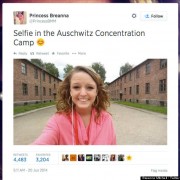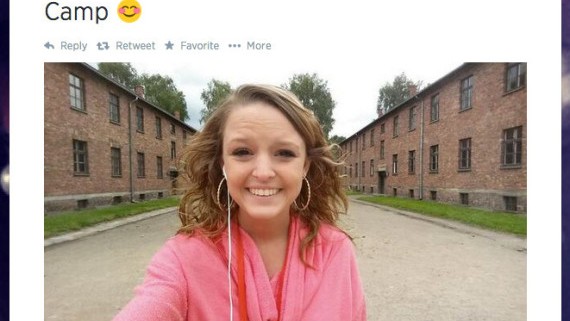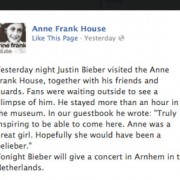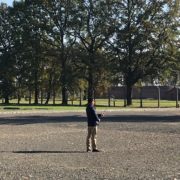“Auschwitz Selfie Girl Defends Actions.”,
“Justin Bieber Hopes Anne Frank ‘would have been a Belieber.” “San Antonio Spurs’ Danny Green Provokes Outrage with ‘Holocaust Selfie.’”
By: Page Garbee
I see this collection of headlines from sources like CNN, The Guardian, and USA Today and think… is the behavior of these individuals, their obsession with self, really that shocking? In no way do I wish to defend these individuals or excuse their actions; however, I honestly can’t say I am surprised. This is the obvious result when Holocaust Memorials are transformed into tourist attractions, rather than sites of remembrance, reflection, and reverence.

“Danny Green (member of the Spurs’ basketball team) takes an inappropriately captioned selfie at the Berlin Memorial to the Murdered Jews” Source: Daily Mail
First and foremost, it should be noted that these incidents featured in the news are not isolated. These individuals are simply the clumsy ones whose insensitive photos and comments sparked outrage in the public and gained traction with various news outlets; they are not the only ones. Step foot inside the gates of Auschwitz or Birkenau and you won’t see the gaunt, starved faces, the hopeless eyes of the prisoners that resided there nearly seventy years ago. Instead, you will see countless groups of bored teenagers, forced to be there, not by Nazis, but by their teachers and school administrators. Witness the groups of girls standing in front of the gate, pushing their lips out to make a “duckface,” and posing for a photo opportunity with their “besties.” Observe the boys whacking each other with the audio equipment dangling from their necks. Every action the adolescents perform and every choice they make over the course of their tour is a sharp contrast to the lives of the prisoners. They follow their guide around, vaguely listening, but also thinking about what they’d like to have for lunch because they’re feeling hungry. They have no way of knowing what true hunger is. They inwardly chastise themselves for not remembering gloves, because it’s a little chilly out. They don’t understand what it is like to truly freeze. Yet they will exit, claiming to have a better knowledge and understanding of evil, suffering, and the Holocaust as a whole; or perhaps all they accomplished was crossing another item off their bucket list.

“Breanna Mitchell’s selfie from the Auschwitz Concentration Camp which led her to be attacked by many on social media” Source: The Huffington Post
To clarify, I do not think that everyone who visits Auschwitz, the Memorial to the Murdered Jews, Anne Frank’s house, or any other Holocaust memorial exhibits this behavior. I merely believe that one is far more likely to witness this behavior and carelessness now due to the perception of the sites as tourist attractions, rather than sites of remembrance. Visiting Auschwitz has become something that people feel as if they are “supposed” to do. Going to Anne Frank’s house or stepping amongst the large pillars of the Memorial to the Murdered Jews is “expected” should one find themselves in the cities of Amsterdam and Berlin respectively. And what better way to tell the world that you’re behaving as you should, than by taking a selfie and posting it on social media?
Though it was written in 1973, Susan Sontag’s essay, “Photography” offers several insights as to why some individuals document these sites of remembrance in the same manner they would any other family vacation. Photography is “a social rite, a defense against anxiety, and a tool of power.” It helps “people to take possession of space in which they are insecure. Thus, photography is linked with one of the most influential of modern activities: tourism.” She notes “most tourists feel compelled to put the camera between themselves and whatever is remarkable that they encounter. Lacking other responses, they take a picture” (pg. 3-4). When confronted with the horrors of a place such as Auschwitz, people tend to require a coping mechanism. They begin to take pictures in an effort to distance themselves from what they are witnessing: the sheer magnitude of human evil and suffering on an industrial scale. But Sontag makes another crucial point. “Once one has seen such images, one has started down the road of seeing more-and more. Images transfix. Images anesthetize…. After repeated exposure to images, it becomes less real” (8-9). As one views cruelty and atrocities through the lens of a camera, one is not only distancing themselves. They are numbing and dulling the reactions of every member of society whenever they share these images with the world to say that they were there. They were present. They did what they were supposed to do.
I believe there is a phenomenon developing, in which people visit sites of remembrance because they feel obligated, rather than out of a desire to connect with the past. I term this phenomenon “going through the motions of remembrance.” It carries with it a severe consequence; it causes people to visit these sites with a preoccupation of self. This serves as a major obstacle to reconciliation, both between different communities as well as between one’s self and the past. In his article, “Invention, Memory, and Place,” Edward W. Said writes about the Israeli Palestine conflict. He says, “There can be no possible reconciliation, no possible solution unless these two communities confront each’s experiences in light of the other” (192). Though he specifically writes about these two communities, his words can be expanded to apply to those who are going through the motions of remembrance.
The only way to solve this problem is for individuals to realize one thing: it isn’t about them. It’s about the persecuted. It’s about the Jews, the Poles, the Romani, the homosexuals, the disabled, and anyone else labeled ‘undesirable’ or ‘subhuman’ by the Nazi party. It’s about the survivors. It’s about the murdered. Two mantras have been iterated throughout the years concerning the Holocaust, “Never again” and “Never forget.” How easy it is to forget when one barely remembers what it is about.











